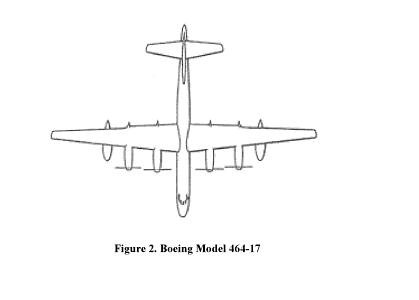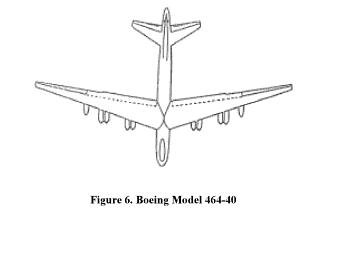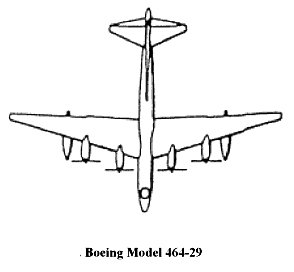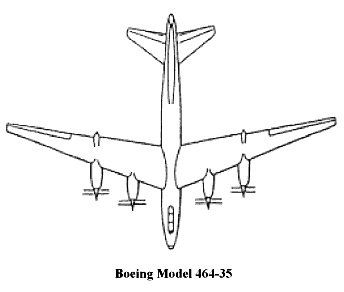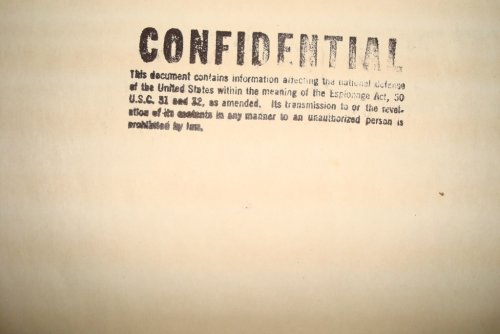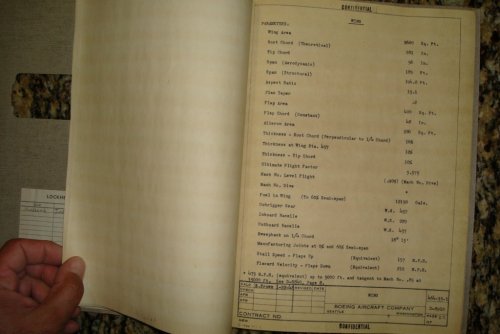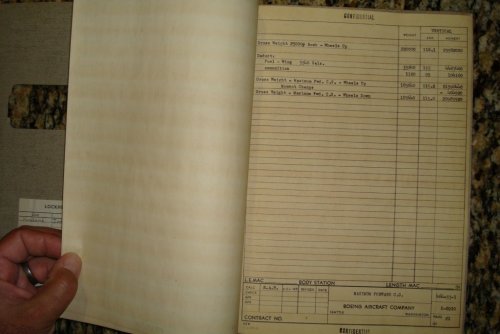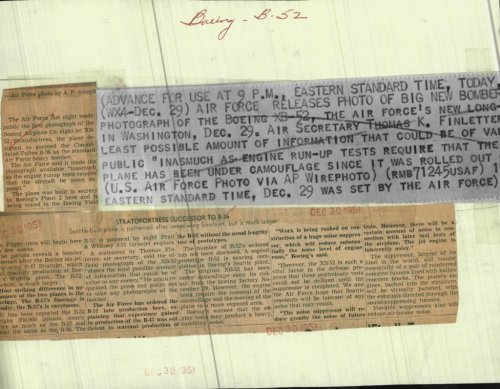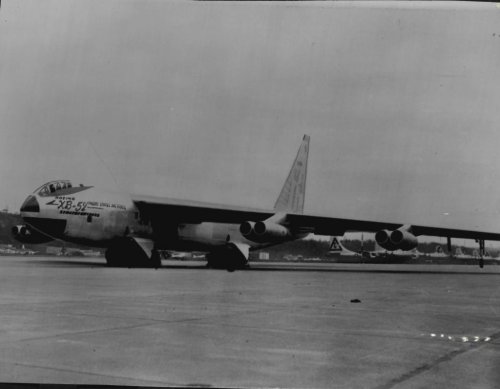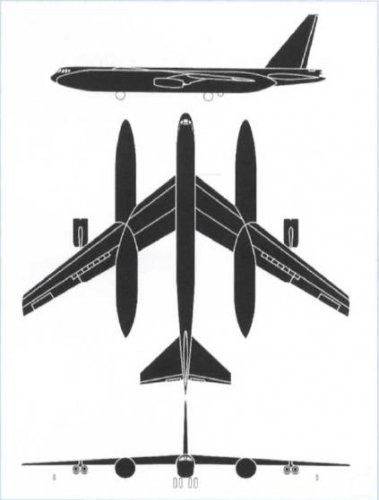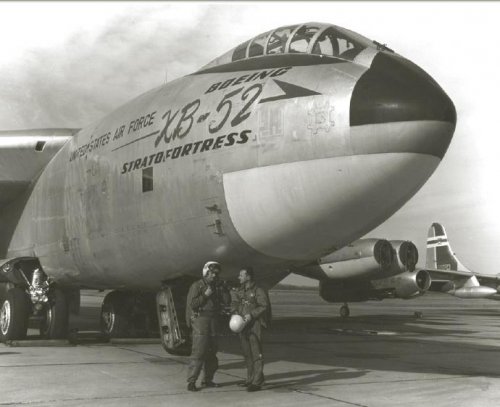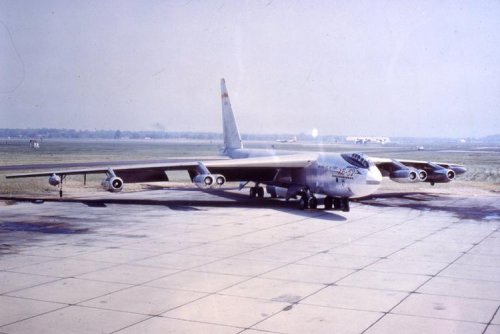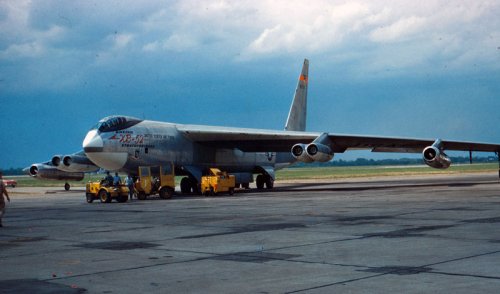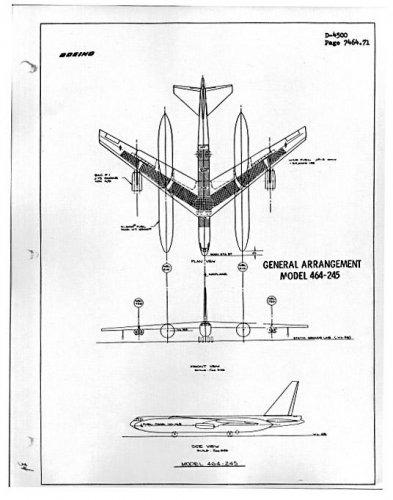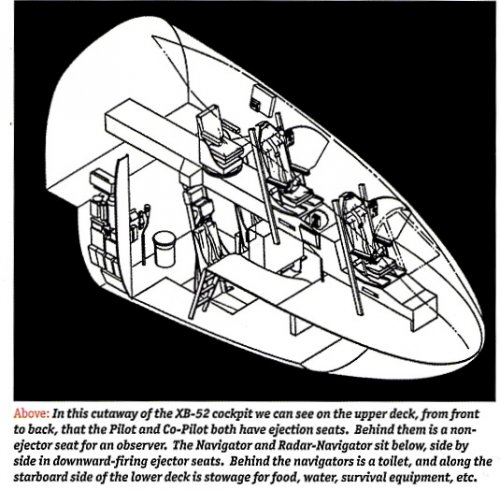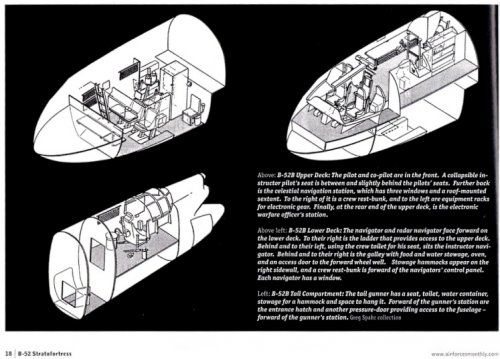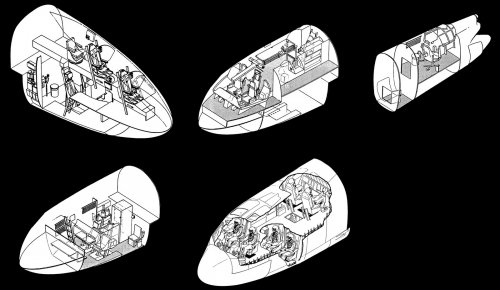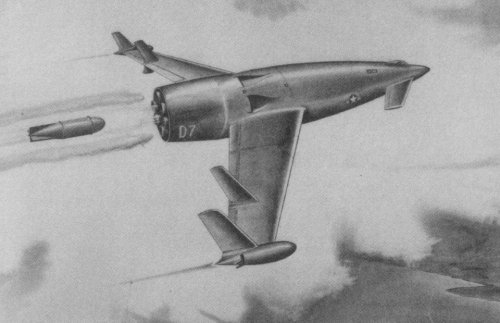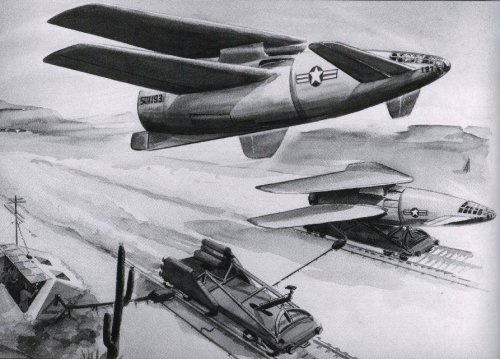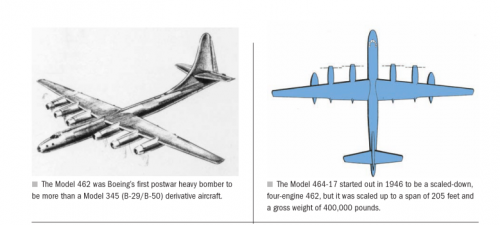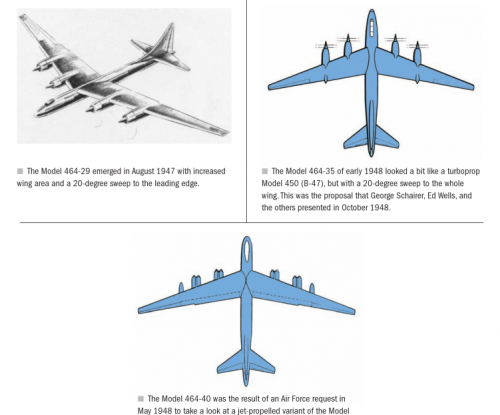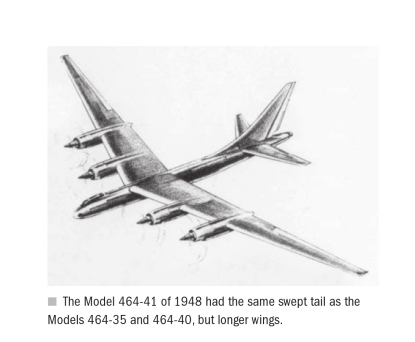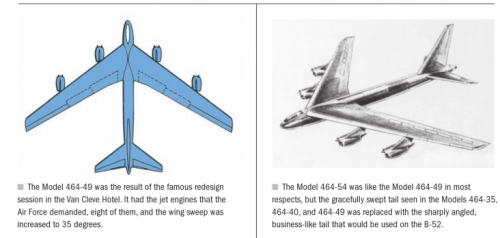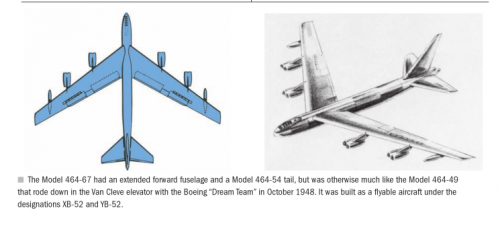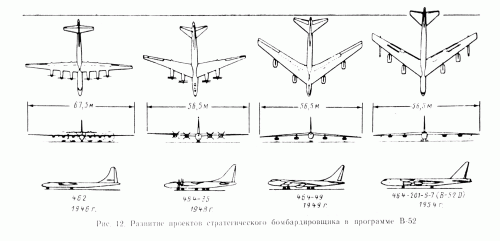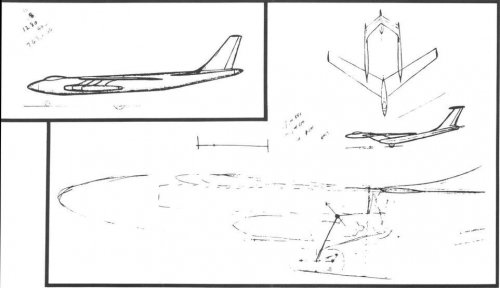You are using an out of date browser. It may not display this or other websites correctly.
You should upgrade or use an alternative browser.
You should upgrade or use an alternative browser.
How the B-52 emerged (Boeing and contending designs to the B-52)
- Thread starter devi
- Start date
- Joined
- 26 May 2006
- Messages
- 34,800
- Reaction score
- 15,685
airman said:The development of the B-52 and jet propulsion :
http://books.google.it/books?id=5cgfJPFbsiEC&lpg=PA55&dq=b-52&hl=it&pg=PP1#v=onepage&q=b-52&f=false
From the same source.
Attachments
- Joined
- 26 May 2006
- Messages
- 34,800
- Reaction score
- 15,685
XP67_Moonbat
ACCESS: Top Secret
- Joined
- 16 January 2008
- Messages
- 2,270
- Reaction score
- 533
Does anyone know the title of the Fairchild M-121 document? Is it even available? I'd love to take a look at it some time. Hell, I'll buy a copy in PDF for the right price. :
Boeing Model 464-33-1 report found on eBay.
Source:
http://www.ebay.com/itm/BOEING-MODEL-464-33-1-REPORT-DATED-1948-/290762696007?pt=LH_DefaultDomain_0&hash=item43b2cea547
Source:
http://www.ebay.com/itm/BOEING-MODEL-464-33-1-REPORT-DATED-1948-/290762696007?pt=LH_DefaultDomain_0&hash=item43b2cea547
Attachments
-
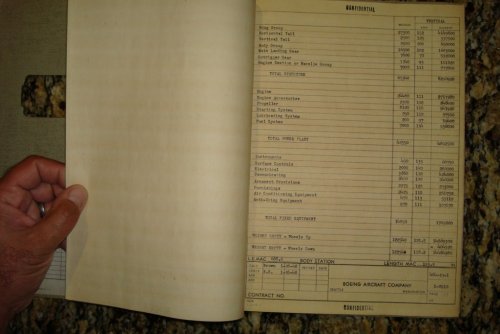 $T2eC16Z,!)kE9s4,BDg,BQLvlH0KH!~~60_57.JPG129 KB · Views: 247
$T2eC16Z,!)kE9s4,BDg,BQLvlH0KH!~~60_57.JPG129 KB · Views: 247 -
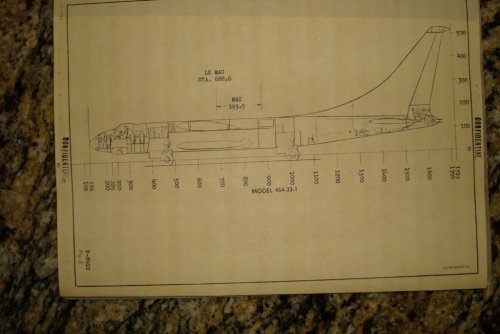 $(KGrHqF,!rUF!dFGoEG2BQLvlFFG2w~~60_57.JPG122 KB · Views: 268
$(KGrHqF,!rUF!dFGoEG2BQLvlFFG2w~~60_57.JPG122 KB · Views: 268 -
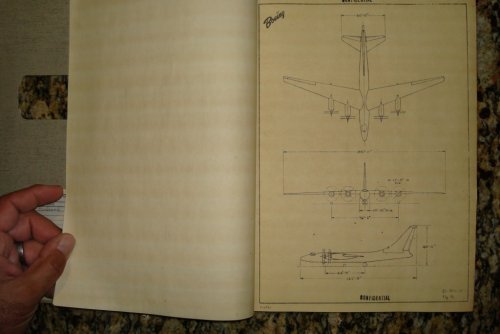 $(KGrHqJ,!qYE+nMeQoJWBQLvlCV+F!~~60_57.JPG102.5 KB · Views: 242
$(KGrHqJ,!qYE+nMeQoJWBQLvlCV+F!~~60_57.JPG102.5 KB · Views: 242 -
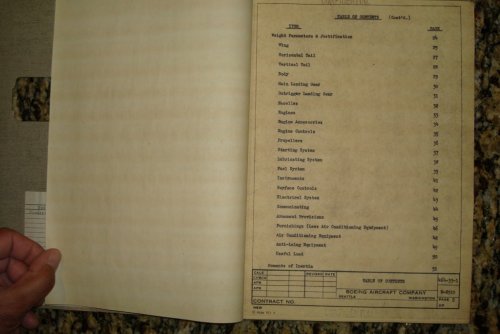 $(KGrHqN,!hcE+4YenyRhBQLvk8uQ8!~~60_57.JPG118.2 KB · Views: 184
$(KGrHqN,!hcE+4YenyRhBQLvk8uQ8!~~60_57.JPG118.2 KB · Views: 184 -
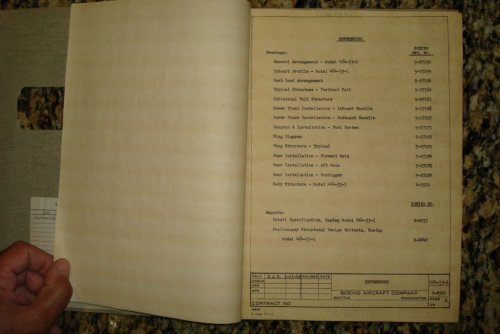 $T2eC16J,!)!E9s2fBWywBQLvk+tWz!~~60_57.JPG118.3 KB · Views: 175
$T2eC16J,!)!E9s2fBWywBQLvk+tWz!~~60_57.JPG118.3 KB · Views: 175 -
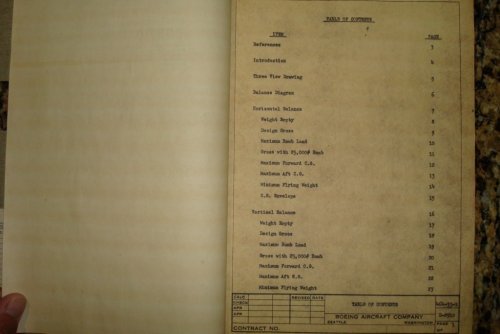 $(KGrHqV,!jUE+rV6MLvFBQLvk55EtQ~~60_57.JPG108.2 KB · Views: 174
$(KGrHqV,!jUE+rV6MLvFBQLvk55EtQ~~60_57.JPG108.2 KB · Views: 174 -
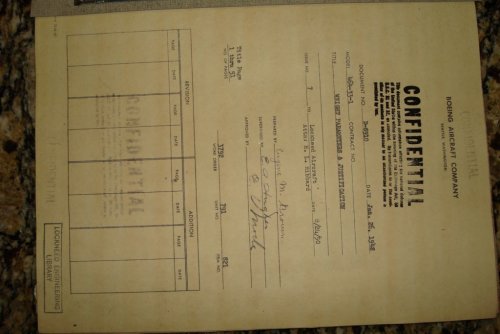 $(KGrHqN,!n0F!J08q,s7BQLvk3OfuQ~~60_57.JPG125.5 KB · Views: 178
$(KGrHqN,!n0F!J08q,s7BQLvk3OfuQ~~60_57.JPG125.5 KB · Views: 178 -
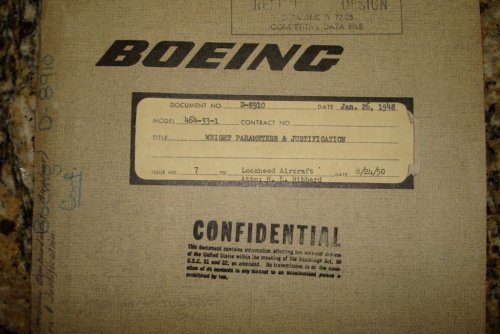 $(KGrHqZ,!i4F!Ji!IvhpBQLvk0Rgow~~60_57.JPG182.3 KB · Views: 180
$(KGrHqZ,!i4F!Ji!IvhpBQLvk0Rgow~~60_57.JPG182.3 KB · Views: 180
Was the Boeing Model 464-33-1 a concept for the Boeing B-52 Stratofortress?
- Joined
- 22 January 2006
- Messages
- 4,206
- Reaction score
- 1,998
Was the Boeing Model 464-33-1 a concept for the Boeing B-52 Stratofortress?
Yes it was. The Model 464 is the model number of the B-52.
Boeing XB-52 and YB-52 model number is 464-67
Boeing B-52A model number is 464-201
Source: Giants of the Sky. Bill Gunston
Other Model 464 iterations illustrated in my sources:
-17
-29
-35
-40
-49
XB-52 Evolution: June 1, 1946

XB-52 Evolution: November 15, 1947

XB-52 Evolution: December 15, 1948

XB-52 Evolution: December 15, 1948

Source:
http://www.enginehistory.org/GasTurbines/Wright/T35/WrightT35.shtml
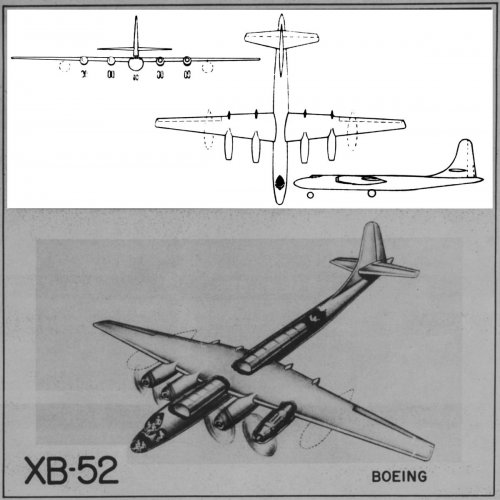
XB-52 Evolution: November 15, 1947
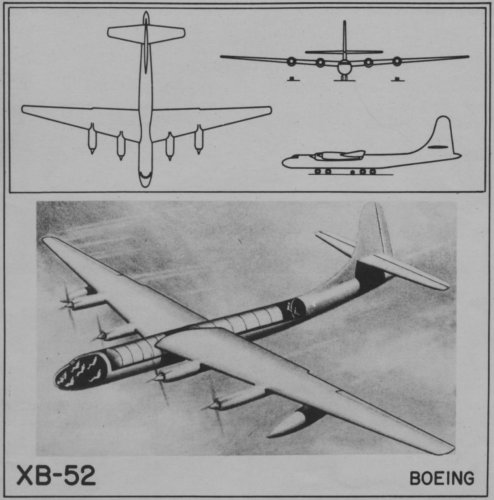
XB-52 Evolution: December 15, 1948
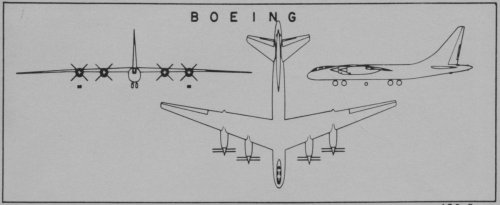
XB-52 Evolution: December 15, 1948
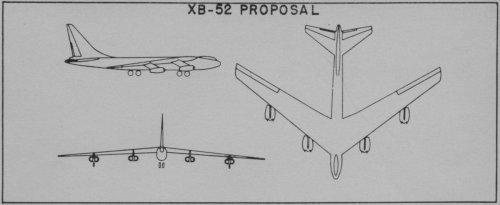
Source:
http://www.enginehistory.org/GasTurbines/Wright/T35/WrightT35.shtml
Last edited by a moderator:
- Joined
- 13 August 2007
- Messages
- 8,402
- Reaction score
- 10,862
wonderful picture, Thx Triton
it had be funny, if B-52 had Turboprop engine. in compares to the Tu-95: looking like unlikely twins ;D
it had be funny, if B-52 had Turboprop engine. in compares to the Tu-95: looking like unlikely twins ;D
- Joined
- 22 January 2006
- Messages
- 4,206
- Reaction score
- 1,998
where can i find more info on Boeing 462
here:
http://www.magcloud.com/browse/issue/8224
Photo of Boeing XB-52 taken December 29, 1951 part of the Seattle Times archive.
Source:
http://www.ebay.com/itm/1951-Boeing-B-52-Strato-Fortress-Press-Photo-/200798437792?pt=Art_Photo_Images&hash=item2ec08501a0
Source:
http://www.ebay.com/itm/1951-Boeing-B-52-Strato-Fortress-Press-Photo-/200798437792?pt=Art_Photo_Images&hash=item2ec08501a0
Attachments
hesham said:the Boeing Model 464-245 was an extra-long-range B-52 bomber variant,
with 157,000-litre external fuel tanks.
That's liquid hydrogen.
Hi friends:
during last months I paid quite a lot of attention to the development of lomg range heavy bombers in the states, and only archiving some pictures I noticed that three shots depict the XB-52 with six engines only.
All of us know that the second prototype (YB-52) actually was flown before first ship that endured some delay, but no one of my books on the matter quotes a six-engine configuration.
Perhaps i read the books not too carefully or is my memory increasingly faltering?
Nico
during last months I paid quite a lot of attention to the development of lomg range heavy bombers in the states, and only archiving some pictures I noticed that three shots depict the XB-52 with six engines only.
All of us know that the second prototype (YB-52) actually was flown before first ship that endured some delay, but no one of my books on the matter quotes a six-engine configuration.
Perhaps i read the books not too carefully or is my memory increasingly faltering?
Nico
Attachments
- Joined
- 26 May 2006
- Messages
- 34,800
- Reaction score
- 15,685
archipeppe
ACCESS: Top Secret
- Joined
- 18 October 2007
- Messages
- 2,431
- Reaction score
- 3,144
hesham said:May be you are right my dear Scott.
It seems unlikely that such B-52 with those monster tanks could take off with only 4 engines (I mean the 2 pods left on wing extremities), considering the the actual B-52 takes 8 engines to be airborne with no extra fuel onboard.
- Joined
- 31 May 2009
- Messages
- 1,154
- Reaction score
- 662
archipeppe said:It seems unlikely that such B-52 with those monster tanks could take off with only 4 engines (I mean the 2 pods left on wing extremities), considering the the actual B-52 takes 8 engines to be airborne with no extra fuel onboard.hesham said:May be you are right my dear Scott.
LH2 weighs about 1/2lb per gallon. JP-4 weighs about 7lbs per gallon (14 times more), so the plane would be a lot lighter, even with these big tanks. In addition, LH2 engines are more efficient, so 4 engines are enough to power a hydrogen-powered B-52.
archipeppe
ACCESS: Top Secret
- Joined
- 18 October 2007
- Messages
- 2,431
- Reaction score
- 3,144
circle-5 said:LH2 weighs about 1/2lb per gallon. JP-4 weighs about 7lbs per gallon (14 times more), so the plane would be a lot lighter, even with these big tanks. In addition, LH2 engines are more efficient, so 4 engines are enough to power a hydrogen-powered B-52.
Theoretically speaking.
Is true that LH2 is lighter than JP-4 but is also true that it takes more volume and requires heavier tanks (due to the cryogenic insulation), furthermore those huge tanks (similiar to the wing pods of TR-1) would surely add drag to the general aerodynamics configuration of the B-52.
At least to me appears like a very rough sketch to illustrate the possibility to have a LH2/B-52 rather than a true engineering project.
- Joined
- 31 May 2009
- Messages
- 1,154
- Reaction score
- 662
Re: How the B-52 emerged (Boeing and contending designs to the B-52)
The attached Boeing drawing was posted elsewhere by OBB about 7 years ago. I think it's safe to say the 464-245 was more than just a "very rough sketch". Yes, those big tanks would have added some drag, but the deletion of four engines, 3,000-gal. underwing tanks, Skybolts, Hound Dogs or bomb racks would have largely made up for that.
In addition to being 14 times lighter, the energy content of LH2 is triple that of kerosene. That's why it is the preferred fuel in modern rocketry. I'm no engineer or chemist, but I trust the ones at Boeing pulled out a slide rule before publishing this design with the company logo on it. Had this variant made sense in other areas, there is no question in my mind that it could have comfortably flown on four engines, as it was engineered to do.
There are many reasons why no practical LH2-powered aircraft has been successfully built, to date. The complex handling and storing of cryogenic fuel is certainly one of them. So is the lack of infrastructure and the considerable cost of operation. But the engineering behind LH2 vehicles is generally sound and has been well-understood for decades.
The attached Boeing drawing was posted elsewhere by OBB about 7 years ago. I think it's safe to say the 464-245 was more than just a "very rough sketch". Yes, those big tanks would have added some drag, but the deletion of four engines, 3,000-gal. underwing tanks, Skybolts, Hound Dogs or bomb racks would have largely made up for that.
In addition to being 14 times lighter, the energy content of LH2 is triple that of kerosene. That's why it is the preferred fuel in modern rocketry. I'm no engineer or chemist, but I trust the ones at Boeing pulled out a slide rule before publishing this design with the company logo on it. Had this variant made sense in other areas, there is no question in my mind that it could have comfortably flown on four engines, as it was engineered to do.
There are many reasons why no practical LH2-powered aircraft has been successfully built, to date. The complex handling and storing of cryogenic fuel is certainly one of them. So is the lack of infrastructure and the considerable cost of operation. But the engineering behind LH2 vehicles is generally sound and has been well-understood for decades.
Attachments
archipeppe
ACCESS: Top Secret
- Joined
- 18 October 2007
- Messages
- 2,431
- Reaction score
- 3,144
circle-5 said:The attached Boeing drawing was posted elsewhere by OBB about 7 years ago. I think it's safe to say the 464-245 was more than just a "very rough sketch". Yes, those big tanks would have added some drag, but the deletion of four engines, 3,000-gal. underwing tanks, Skybolts, Hound Dogs or bomb racks would have largely made up for that.
In addition to being 14 times lighter, the energy content of LH2 is triple that of kerosene. That's why it is the preferred fuel in modern rocketry. I'm no engineer or chemist, but I trust the ones at Boeing pulled out a slide rule before publishing this design with the company logo on it. Had this variant made sense in other areas, there is no question in my mind that it could have comfortably flown on four engines, as it was engineered to do.
There are many reasons why no practical LH2-powered aircraft has been successfully built, to date. The complex handling and storing of cryogenic fuel is certainly one of them. So is the lack of infrastructure and the considerable cost of operation. But the engineering behind LH2 vehicles is generally sound and has been well-understood for decades.
Dear Circle-5 many thanks for the explanation and for the enclosed drawing, now it makes more sense to me.
Regarding the LH2 story we know that Lockheed pioneering such tecnique since the CL-400/Suntan project (a forerunner of A-12/SR-71 family) and also during mid 80's it was seriously considered for civil airliner applications (at least Russians really flown a LH2 aircraft if my memory doesn't fail).
Indeed another thought about the LH2 usage as military propellant: how much risky was to fly a bomber over a huge defended area (I mean with SAMs and MiGs) with those huge and vulnerable tanks filled with highly volatile liquid hydrogene??
- Joined
- 3 June 2006
- Messages
- 3,092
- Reaction score
- 3,941
XB-52 cockpit cutaway. For comparison cutaways of B-52B cockpit and its decks.
Edit:
Added comparison cutaways from the XB-52 to B-52H cockpits and their decks.
Sources:
B-52 Stratofortress - Celebrating 60 remarkable years - Air Force Monthly Special Edition 2012
https://www.flickr.com/photos/53504020@N08/7435921646/
Edit:
Added comparison cutaways from the XB-52 to B-52H cockpits and their decks.
Sources:
B-52 Stratofortress - Celebrating 60 remarkable years - Air Force Monthly Special Edition 2012
https://www.flickr.com/photos/53504020@N08/7435921646/
Attachments
- Joined
- 9 October 2009
- Messages
- 21,928
- Reaction score
- 13,540
Skybolt said:Well, ladies and gentlemen, since "shazam" is copyrighted, I'll resort to my:
beebeedee, bobeedee, boo!
Just received from the Smithsonian (with much more), here is the 3view of the Fairchild M-121, which, born under the cover of the Generalized Bomber Research (which wasn't limiited to the Convair GeBo I and II studies) and designed in 1949, during 1950 was considered (alongside at least two Douglas design, the D-1211J and R) as a "dark horse" alternative to the XB-52 program. I don't know if it has already been published elsewhere, but I doubt it... Anyhow, enjoy...
Hats off to thounaojamtom over at MilitaryPhotos.net for these (M-121 and M-128):
Attachments
archipeppe
ACCESS: Top Secret
- Joined
- 18 October 2007
- Messages
- 2,431
- Reaction score
- 3,144
Grey Havoc said:Skybolt said:Well, ladies and gentlemen, since "shazam" is copyrighted, I'll resort to my:
beebeedee, bobeedee, boo!
Just received from the Smithsonian (with much more), here is the 3view of the Fairchild M-121, which, born under the cover of the Generalized Bomber Research (which wasn't limiited to the Convair GeBo I and II studies) and designed in 1949, during 1950 was considered (alongside at least two Douglas design, the D-1211J and R) as a "dark horse" alternative to the XB-52 program. I don't know if it has already been published elsewhere, but I doubt it... Anyhow, enjoy...
Hats off to thounaojamtom over at MilitaryPhotos.net for these (M-121 and M-128):
The M-128 has a strong resemblance with the von Braun's Collier's spaceplane....
- Joined
- 9 October 2009
- Messages
- 21,928
- Reaction score
- 13,540
No problem!
The old post below explains the 'auxiliary wing'.

The old post below explains the 'auxiliary wing'.
Skybolt said:Thanx...
Actually it could be the opposite. During 1949-50 NACA conducted a series of wind-tunnel tests on a configuration very similar to the M-121's one (only slimmer). Could be that Wernher while at Redstone saw them....
And since you want more, here is it... but I want to write an article on this (Air Enthusiast, any one?), so I'll be VERY parsimonious... Bu the forum is the forum, so.. from which you can see the famous railroad take-off concept and another big surprise: the auxiliary wing for very long range mission (it was full of fuel, more then doubling the total onboard). This is why someone had M-121 described as a "flying wing" perhaps....
Hot Breath
I really should change my personal text
- Joined
- 11 March 2014
- Messages
- 196
- Reaction score
- 12
Was the slip wing recoverable? Was it piloted separately? I can't see any cockpit, if that was the case.
XP67_Moonbat
ACCESS: Top Secret
- Joined
- 16 January 2008
- Messages
- 2,270
- Reaction score
- 533
No it was like a big drop tank. If you want the full story you should check out Jared Zichek's book
Secret Aerospace Projects of the U.S. Navy: The Incredible Attack Aircraft of the USS United States, 1948-1949
http://www.amazon.com/Secret-Aerospace-Projects-U-S-Navy/dp/0764332295
Secret Aerospace Projects of the U.S. Navy: The Incredible Attack Aircraft of the USS United States, 1948-1949
http://www.amazon.com/Secret-Aerospace-Projects-U-S-Navy/dp/0764332295
- Joined
- 26 May 2006
- Messages
- 34,800
- Reaction score
- 15,685
Attachments
- Joined
- 25 June 2009
- Messages
- 14,722
- Reaction score
- 6,054
Steve Pace
Aviation History Writer
- Joined
- 6 January 2013
- Messages
- 2,266
- Reaction score
- 225
Excellent! -SP
- Joined
- 26 May 2006
- Messages
- 34,800
- Reaction score
- 15,685
Hi,
http://scilib-avia.narod.ru/Boyne/B-52.htm
Below: Some of Ed Well's pencil sketches during the days preceding the B-52 design. They are remarkable both for how close they came to the final configuration, and how radical were some of the departures. (Boeing)
http://scilib-avia.narod.ru/Boyne/B-52.htm
Attachments
Similar threads
-
Boeing B-52 Replacement Bomber Project ?
- Started by hesham
- Replies: 9
-
-
-
-

